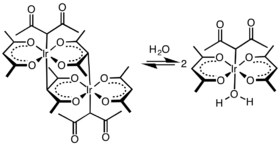Iridium acetylacetonate
Iridium acetylacetonate is the iridium coordination complex with the formula Ir(O2C5H7)3, which is sometimes known as Ir(acac)3. The molecule has D3-symmetry.[2] It is a yellow-orange solid that is soluble in organic solvents.
3.png) | |
| Identifiers | |
|---|---|
3D model (JSmol) |
|
| ECHA InfoCard | 100.036.086 |
PubChem CID |
|
CompTox Dashboard (EPA) |
|
| |
| Properties | |
| C15H21IrO6 | |
| Molar mass | 489.544 g·mol−1 |
| Appearance | orange solid[1] |
| Melting point | 269 to 271 °C (516 to 520 °F; 542 to 544 K) (decomposes) |
Except where otherwise noted, data are given for materials in their standard state (at 25 °C [77 °F], 100 kPa). | |
| Infobox references | |
Preparation and isomerism
It is prepared from IrCl3(H2O)3 and acetylacetone.[3] The complex has been resolved into individual enantiomers by separation of its adduct with dibenzoyltartaric acid.[4]
A second linkage isomers is also known. In the second isomer one of the acetylacetonate ligands is bonded to Ir through carbon.[5]

Uses
The O6-bonded isomer has been investigated for use chemical vapor deposition (CVD). One example is the deposition of red phosphorescent emitter compounds used in OLEDS.[6][7]
The C-bonded isomer has been investigated as a catalyst for C-H activation reactions.[5]
References
- Iridium acetylacetonate
- V. G. Isakova, I. A. Baidina, N. B. Morozova, I. K. Igumenov "γ-Halogenated iridium(III) Acetylacetonates" Polyhedron 2000, Volume 19, Pages 1097–1103. doi:10.1016/S0277-5387(00)00358-2
- James E. Collins, Michael P. Castellani, Arnold L. Rheingold, Edward J. Miller, William E. Geiger, Anne L. Rieger, Philip H. Rieger "Synthesis, Characterization, and Molecular Structure of Bis(tetraphenylcyclopentdienyl)rhodium(II)" Organometallics 1995, pp 1232–1238. doi:10.1021/om00003a025
- Drake, A. F.; Gould, J. M.; Mason, S. F.; Rosini, C.; Woodley, F. J. (1983). "The optical resolution of tris(pentane-2,4-dionato)metal(III) complexes". Polyhedron. 2 (6): 537–538. doi:10.1016/S0277-5387(00)87108-9.CS1 maint: uses authors parameter (link)
- S. M. Bischoff, R. A. Periana (2010). Oxygen and Carbon Bound Acetylacetonato Iridium(III) Complexes. Inorganic Syntheses. 35. p. 173. doi:10.1002/9780470651568. ISBN 9780470651568.CS1 maint: uses authors parameter (link)
- "Synthesis of a high-efficiency red phosphorescent emitter for organic light-emitting diodes"
- "Highly Phosphorescent Bis-Cyclometalated Iridium Complexes: Synthesis, Photophysical Characterization, and Use in Organic Light Emitting Diodes"